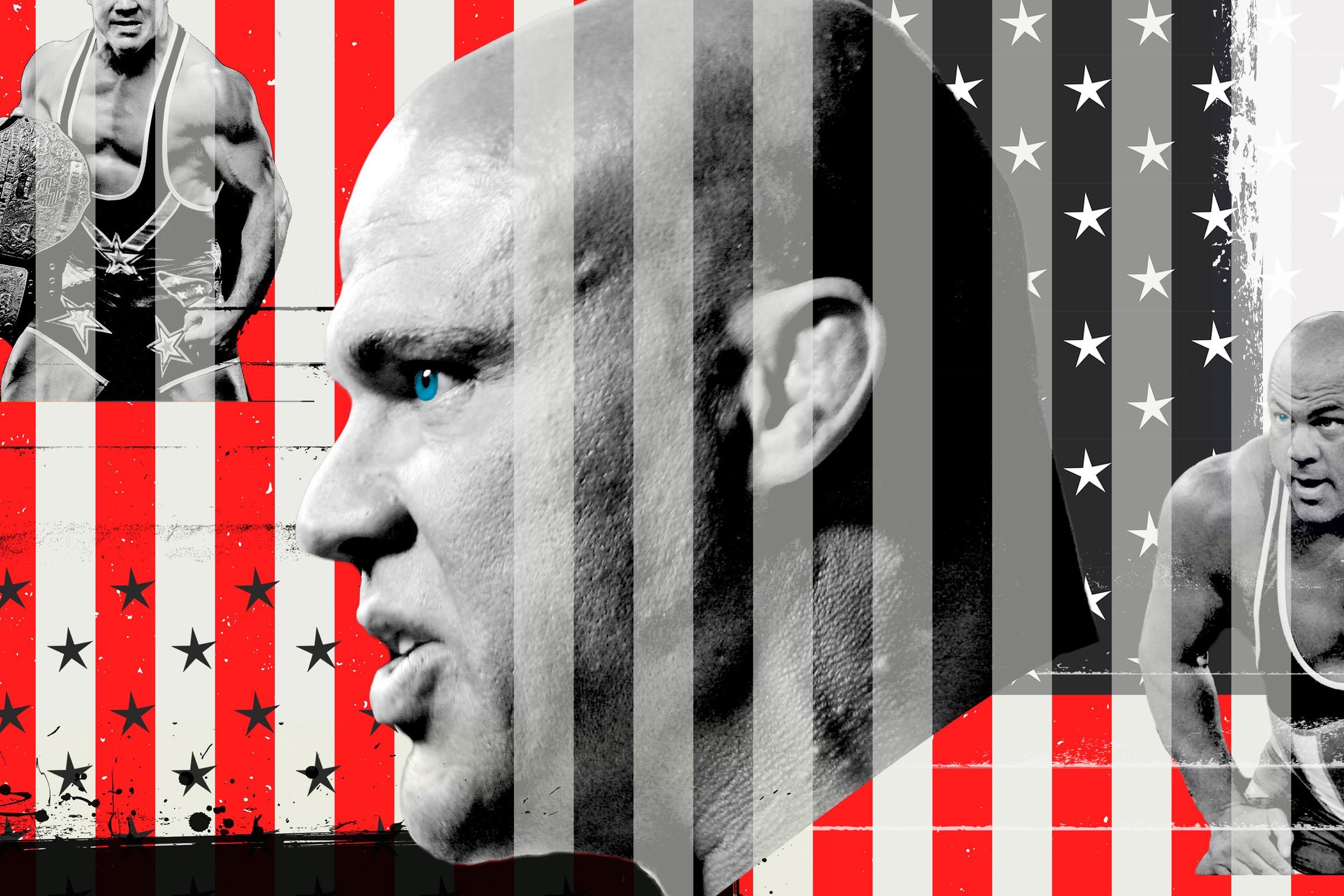The Wrestling Machine at Rest
Kurt Angle — gold-medal winner, wrestling icon, relentless ring general — is finally being inducted into the WWE Hall of Fame. But not before enduring five broken necks, family tragedy, and a devastating addiction to painkillers.Get Kurt Angle talking about professional wrestling long enough and he will inevitably use the phrase "five-star match." Dave Meltzer, publisher and editor of the influential Wrestling Observer Newsletter, popularized the term, a subjective assessment of wrestling matches no different than a movie review. The first five-star match was between Dynamite Kid and Tiger Mask I at the New Japan Pro Wrestling Sumo Hall Show on April 21, 1983. Since then, 81 more matches have received the distinction.
A five-star match is wrestling’s equivalent of the five-mic rating in hip-hop, the old standard for classic albums during The Source magazine’s heyday. It’s an honor that’s nothing more than one opinion, which is why it’s a little strange when the performers — wrestlers or rappers — crow about them; for years, Kanye West obsessed over mic ratings, if that tells you anything about the type of mind we’re dealing with here.
Kurt Angle uttered the words "five-star match" four times during a 90-minute interview last week. The best usage (i.e. the most Kanye) came when he said, "I was the best pro wrestler of my time and possibly of all time. I probably had more consistent four- and five-star matches than any other wrestler in history." (Fact check: Mr. Angle’s statement is misleading. Though he never received a five-star match rating from Mr. Meltzer, he was named Wrestling Observer Newsletter Wrestler of the Decade for 2000–09.)
"Five-star matches," says Ethan Carter III, the TNA wrestler who feuded with Angle in recent years. "He loves that term."
For Angle, five-stars fed his ego, but they also represented his passion for the business and his willingness to entertain, whether at a house show in Macon, Georgia, or at the top of the card at WrestleMania in Madison Square Garden. There are no half-measures for Kurt Angle. There’s just one problem with that: Angle has gotten injured time and again throughout his career. Seriously, seriously injured.
What made Angle so good at his job — the intensity, focus, and dedication — is what led to five broken necks, a prescription drug addiction, and an 11-year exile from WWE.
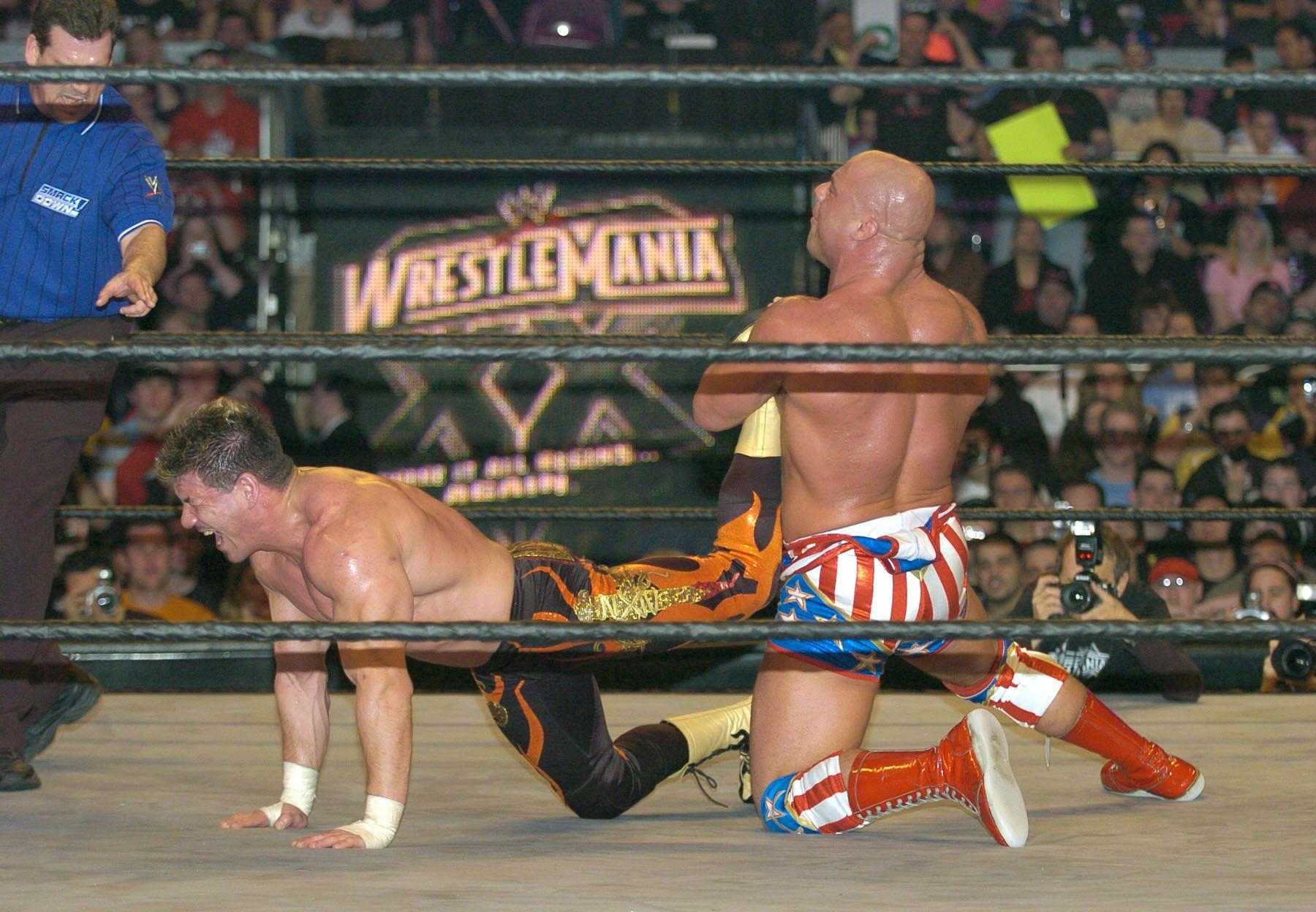
Now sober, Angle and the company have reunited; Angle, ever the canny pro wrestler pushing an angle, had lobbied WWE chairman Vince McMahon and Triple H for a return since 2014, a few months after he got clean the year before. The January announcement that Angle would enter the WWE Hall of Fame on Friday night, before WrestleMania, led to speculation, of course, about a potential in-ring return. Angle is cagey about whether or not he’ll wrestle again. "I don’t know," he says. "If you’re asking me personally, yes. They won’t tell me anything. Triple H told me straight up, ‘We’re not talking about anything until after the Hall of Fame. If we decide that you wrestle, which is not a definite, you’re going to have to pass a physical.’ I said, ‘OK, cool.’"
Angle sits in a firm, uncomfortable chair in the lobby of the Hyatt Regency hotel in Pittsburgh. He’s on brand for an Olympic hero: black Nikes; red, white, and blue gym shorts; red tank top; and blue zip-up hoodie. He is stout and muscular with a trim waist. His jaw is strong, his head is shaved clean, his eyes, a piercing shade of sky blue. Angle smiles. Is he working me?
"I can tell you this: I will work with the company. That doesn’t mean that I will wrestle," he says. "There is no guarantee I’m gonna be on TV either." The latter statement is meant to squelch rumors that he’ll be the new general manager of WWE’s Raw.
What we can confirm is that Kurt Angle, the only Olympic gold medalist in WWE history, will be back on the road soon with the company as an ambassador of sorts. He will make appearances, promote the product, possibly be an on-air authority figure, and definitely will not wrestle. He’s a 48-year-old with a bum neck who, after decades of destructive behavior, is finally a functioning adult. He has found happiness with his family. He is healthy. He isn’t destitute. So why is he willing to return to the business that nearly destroyed him?

"When Kurt first got into the ring," remembers Bruce Prichard, former WWE VP of talent relations, "he took to it quicker than anyone I’d ever seen or have seen since."
What made Angle so great? He was an Olympic champion, but pro wrestling is more than that. Angle fully committed to his character, no matter the direction WWE’s creative department took it. If he was booked as a goof, like during his debut run from 1999–2002, he was more than willing to play the fool; if he was booked as a destroyer (think his 2005 feud with Shawn Michaels), he turned into an assassin, John Wick in a red, white, and blue singlet, punishing opponents with German suplexes, Angle slams, and ankle locks.
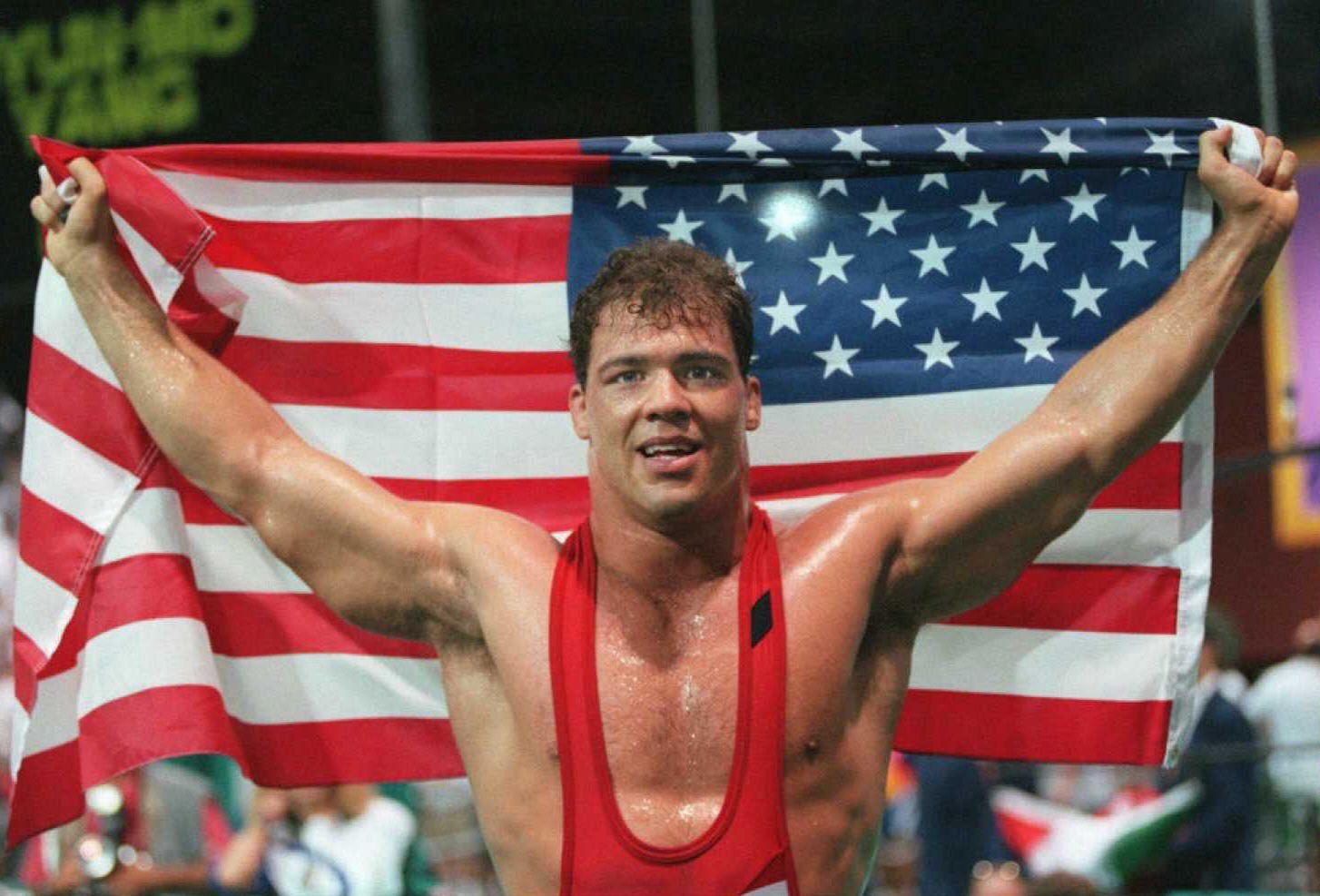
He also had the perfect gimmick; he could slip right into the character he played on television. Vince McMahon’s brilliant idea was that Kurt Angle, the Olympic gold medalist, who worked harder and was more talented than the Average Joe, would play Kurt Angle, a pompous Olympic gold medalist who worked harder and was more talented than the average Joe … and was also kind of a dick. "It made it so easy for me," Angle says. "All I had to do was listen to Vince and toot my gold medal."
As McMahon predicted, fans hated Angle upon his debut in November 1999, and he quickly ascended through the mid-card and into the main event, capturing the European Championship, Intercontinental Championship, and winning the 2000 King of the Ring tournament along the way. He closed his rookie campaign in October, defeating the Rock for the WWE Championship at No Mercy. He was recognized as one of the best performers in the business from both his peers and the critics; Angle won the Wrestling Observer Newsletter’s Most Outstanding Wrestler Award from 2001 to 2003. As Stone Cold Steve Austin and the Rock eased into retirement and movies, respectively, Angle was the bridge between the Attitude Era and John Cena’s reign, a sometimes forgotten link that binds two generations.
Angle understood ring psychology, particularly how to draw fans into a match, and was a ring general capable of improvising in even the toughest circumstances. After Brock Lesnar botched the finish of their match in the main event of WrestleMania XIX, missing a shooting star press and almost breaking his neck, Angle ensured the match didn’t miss a beat. "Boot me in the gut and give me an F5 [Lesnar’s finishing move]," he whispered to a dazed Lesnar. Moments later, kick, boom, F5, one, two, three, "AND THE NEW … !!!"
But it was Angle’s world-class athleticism, the gift that won him the Olympic gold medal in freestyle wrestling at the 1996 Atlanta games, that made him stand out. He was strong and fast with incredible body control, a powerful center of gravity, and otherworldly stamina. He had grace in the ring, not a trait associated with his line of work. And more than anyone before or after him, Angle made professional wrestling look like a competition, some sort of sport. He made it look real.
"I just had a knack for it," he says. "I had a knack for what would capture the imagination."
When Rey Mysterio thinks about Angle’s talent, the first thing that comes to mind is SummerSlam 2002, Mysterio’s WWE pay-per-view debut after a 14-year career in Mexico, ECW, and WCW. As a high flyer, Mysterio was without peer, a proponent of the frenzied lucha libre style. Before facing someone for the first time, Mysterio considered how his opponent would handle his unique moves. Angle eased Mysterio’s concerns before the match. "He told me that he literally wanted me to pull out my whole arsenal and was willing to take every move to make me look good," Mysterio tells me. "For him to adapt to my style, that made me go, ‘Wow, OK, Kurt is the man.’"
Mysterio points to the opening sequence, when he jumped Angle from behind, surprising him with a springboard headscissors takedown. "For him to be at that precise spot, catch me, be able to tuck in so I don’t fall face first and still take his bump?" Mysterio recalls, still in awe. "A lot of people can’t do that. A lot of people would have made that look really bad."

Despite their memorable battles — including at No Mercy 2002, a tag-team affair between Mysterio and Edge vs. Angle and Chris Benoit, a 4.75 on the Meltzer star scale — Rey Mysterio was not Kurt Angle’s greatest opponent. It wasn’t Stone Cold Steve Austin or the Rock or Triple H or John Cena or Brock Lesnar. It was drugs.
Angle started taking painkillers after breaking his neck during a match with Lesnar in February 2003. Later that year, after his sister, LéAnne, died of a heroin overdose, he began doubling the dosage. "When I took those pills, I didn’t care anymore about LéAnne and my neck felt better," he tells me. "Some people get sick on painkillers. Some people get tired. They made me feel invincible."
His drug of choice was Vicodin ES (Extra Strength), and, at the height of his addiction, he was taking 65 daily; 18 upon waking simply to stop the shakes. He befriended the kind of doctors who’d write prescriptions in exchange for hobnobbing with an Olympic hero. And he became savvy, junkie smart, keeping a notebook to track his multiple scripts and the pharmacies where he scored.
"Every time he went on the road, I was afraid that I was going to get that phone call that something had happened," Angle’s ex-wife Karen Jarrett told me in a 2011 interview. "There were more than a few close calls." According to reports, EMTs were called to Angle’s house on June 2, 2006, when he wouldn’t wake up.

By that point the rumblings about his health from within the WWE locker room had reached upper management; Angle’s June 2006 suspension didn’t quell their suspicions. And it took a toll on his relationship with Vince McMahon, whom Angle considered a father figure.
Angle recalled how in the good ol’ days, McMahon would call him at midnight on New Year’s Eve. "You knew you were the first call," Angle says. "That made you know you were the guy." Angle claims McMahon ignored his calls during summer 2006. "I think I became a pain in the ass," Angle says. "All I would do was complain to him. I felt like I was losing my spot to this young kid named John Cena. I started threatening Vince. I was sending him texts." (A WWE spokesperson said McMahon was unavailable for comment.)
Angle got hurt again upon returning from suspension, injuring his groin, hamstring, and abdominal muscle in a match with Rob Van Dam. His behavior turned more erratic. Bruce Prichard remembers Angle pulling down his pants after the injury to reveal a grotesque bruise stretching from hip to hip.
"Kurt had all these nagging injuries and, instead of taking time off to get better, he was self-medicating," Prichard tells me. "Guys become experts at masking their injuries and powering through it. As a talent — and I’ve been there — you don’t want to lose your spot, you don’t want people to consider you unreliable, you don’t want to miss out, and then that paranoia sinks in."
It was becoming increasingly clear that Angle could either go to rehab and keep his job or continue using drugs. He chose drugs. On August 25, 2006, WWE granted Angle his release after a meeting at WWE headquarters in Stamford, Connecticut. Angle and McMahon would not speak for nearly 10 years.

Angle’s family is no stranger to addiction. When Kurt was 16, his father, David, who’d pound rum after dinner until passing out, died following a workplace accident at a construction site. Angle, who describes his father as "an alcoholic," believes he was drunk on the job. Some of his siblings weren’t spared either. Prior to her 2003 death, LéAnne did numerous stints in rehab. And in 2015, Angle’s oldest brother, Dave, killed his wife in an incident the defense attorney said was alcohol-related; Angle says that his brother was also addicted to various prescription pills. Dave was sentenced to up to 10 years in prison after pleading guilty to one count of voluntary manslaughter.
"That was tough," Angle says. "I was very close with my sister-in-law. My brother was the most compassionate guy, never violent. If he could have done that?"
"Drugs," he says, "ruined my family."

Before the tragedies, sports defined the Angle family dynamic. Dinner-table conversations revolved around amateur wrestling and high school football, and all the children regaled David with accounts of their progress. As the baby of the family with four big brothers pushing him, Angle had a lot to prove. "Being a part of the Angle family," he says, "if you weren’t a badass at something, you were nothing."
He emulated his brothers at first, taking a physical approach to wrestling; hurting opponents took precedent over scoring points. But he didn’t succeed until he realized that fitness, technique, and speed were his strengths. He won states at Mt. Lebanon High School, and, despite being undersized for a heavyweight, starred at Clarion University of Pennsylvania, winning two Division I championships.
"He was relentless in the weight room and relentless in the practice room," recalls former Clarion wrestling coach Robert Bubb. "In between classes, he’d work on his technique, and it wasn’t anything you had to make him do or ask him to do."
Wrestling sheltered Angle from drugs, alcohol, and partying. From the moment he won his first tournament in ninth grade, he always had an eye on the next goal: states, junior nationals, the NCAAs, the U.S. Open, the World Championships, the Olympic trials, and finally, the Olympics, which he won while recovering from two fractured cervical vertebrae and two herniated disks — a "broken freakin’ neck" as he would later boast in WWE.
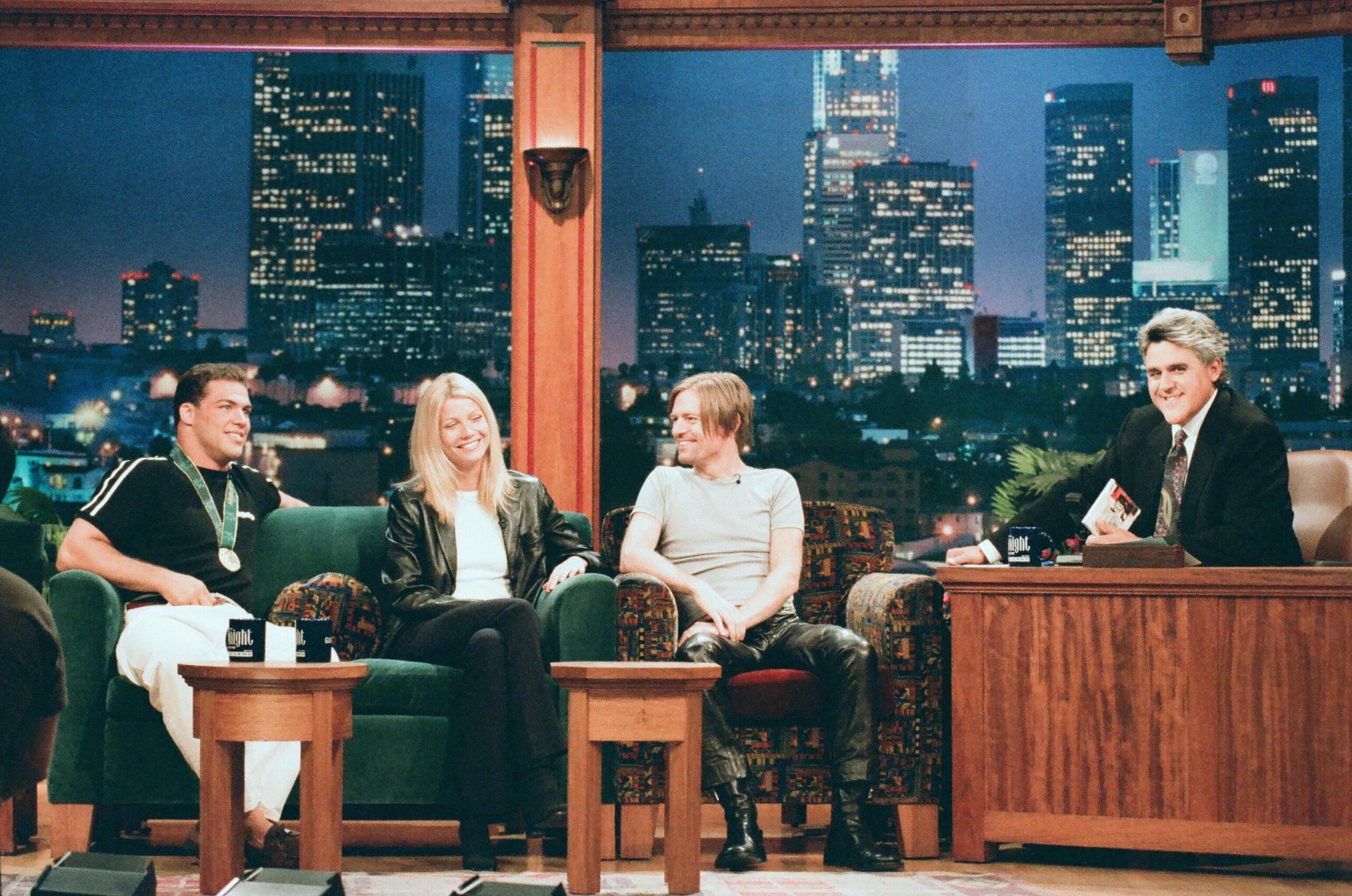
The victory made him an American hero, which meant he promptly embarked on a press run. One night he landed on The Tonight Show couch next to Gwyneth Paltrow. "I told her that it was an honor to meet her," Angle remembers. "She said, ‘Gee, it’s a bigger honor to meet an Olympic gold medalist.’ I thought, ‘Wow, that’s really cool.’ I was trying to be smooth, so I lifted my arm up to put it behind the chair to turn toward her to talk. As I did, my elbow hit her drink and it spilled all over her blouse. We were in commercial and the whole crowd started laughing. She didn’t talk to me the rest of the night."
More than joy, Angle felt relief after winning gold. Aimless in the following weeks and months, he was suffering from a lack of purpose. For the first time in a decade, he didn’t have to train 10 hours a day. There was no next tournament, no next target. He was too young to coach wrestling and not good enough for pro football (he tried out for the Steelers in 1995). UFC wasn’t an option at the time. A meeting with WWE went nowhere after Angle, who didn’t watch professional wrestling growing up, declared that if he wrestled for WWE he could never lose because, as an Olympic gold medalist, it wouldn’t be believable.
"‘Nice to meet you,’" Bruce Prichard remembers saying. "‘Good luck with your gold medal.’"
Angle instead took a sportscaster gig at the local Fox affiliate. The sedentary work — early mornings, late nights, staring at a computer all day — was no life for a jock, and he proved stiff in front of the camera. In October 1998, having learned more about the business and having tasted failure in the professional world, Angle met again with Vince McMahon, who’d long considered the gold-medal winner a potentially viable in-ring asset. He signed with WWE shortly thereafter, beginning a nearly eight-year relationship that ended with Angle sobbing in McMahon’s office during summer 2006.

Angle debuted in TNA wrestling two months later, and over the years produced some of his best work in feuds with Samoa Joe, AJ Styles, and Nigel McGuinness (then known as Desmond Wolfe). Though he eventually recovered from his painkiller addiction, Angle remained an emotional wreck. He went through a public divorce in 2008, when his wife Karen left him for his boss, TNA cofounder Jeff Jarrett; this being professional wrestling, the scandal became a story line.
Angle also developed a taste for new drugs. He was prescribed a time-release morphine called MS Contin for his neck injuries and Xanax to help with his anxiety. To feed his addiction, he devised a way to get extraordinarily high. He would save his medication — four Xanax, two MS Contin — until the evening, chase it with a few beers, and then, if he didn’t pass out on the couch, go for a drive. Things worsened after that. In 2009, he was acquitted of a harassment charge brought against him by ex-girlfriend and fellow TNA employee Trenesha Biggers. He was arrested on three separate drunk-driving incidents, once in 2007 and twice in 2011.

He tried turning his life around after the third arrest. He married Giovanna Yannotti, an actress he befriended on the set of Warrior, where he played a Russian MMA fighter named Koba. He also announced he was trying out for the 2012 London Olympics, a quixotic attempt given that he was a 42-year-old with a drug addiction and still under contract with TNA. "I knew that I would’ve been kicked off the team if I made it," Angle says. "I just wanted to do something physical again that gave me the feeling I got in the [1996] Olympics." He couldn’t stay healthy during training, unable to push his body the way he could when he was half as old.
Angle hit bottom when he was arrested for DWI on August 1, 2013, in Wise County, Texas, following a TNA show. He called Giovanna from jail, and, when she picked up, she delivered an ultimatum: Get clean or I’m leaving. Angle immediately entered a rehabilitation center.
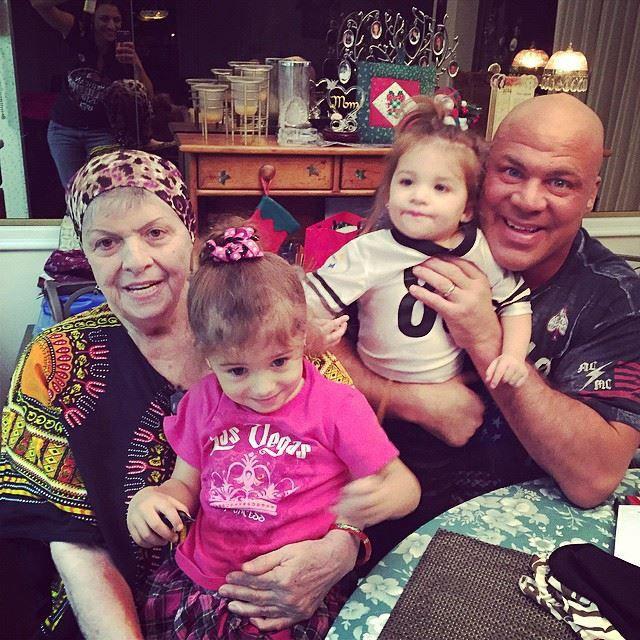
During Angle’s visit to rehab, he realized a few uncomfortable truths. He learned that throughout his life he had used competition to suppress his feelings. He didn’t cry at the hospital when his father was on life support, opting instead to prep for football practice. It took him more than a week before he shed tears. After John du Pont infamously murdered Dave Schultz, Angle’s wrestling coach and mentor, in January 1996, Angle continued to train for the Olympics. He wrestled his lauded 60-minute iron-man match against Brock Lesnar on the night after LéAnne overdosed, hitching a ride on Vince McMahon’s private jet afterward to make the funeral in time.
More than anything, Angle learned that, even before his addiction, he was a selfish human being. "My whole life was about me," he says. "All I ever did was fulfill myself with my success. I don’t know how to do anything but what I do because of my selfishness."
Once Angle left rehab, he aspired to help others with their own post-recovery care. In 2016, he met Dr. Harold Jonas, a licensed mental health counselor and an addiction and recovery expert in Delray Beach, Florida, and together they launched the AngleStrong app (a rebranding of Jonas’s FlexDek app). AngleStrong costs users $1 per day and has features such as a monthly video call from Angle to subscribers, a chat line, and recovery tips in an attempt to limit relapses. Subscribers are required to check in daily and answer survey questions (Did you got to a meeting today? Did you do something good for another person?). An alert is sent to the subscriber’s support network if they don’t check in.
"It does hold people accountable," Angle says. "It will give people structure, at least the structure people need to stay in recovery."
Like most people recovering from addiction, Angle craves structure and order. He begins every day with a routine. Around 6:30 a.m., he performs maintenance on his battered body: stretching, yoga, foam rollers, fascia massages, anti-gravity, neck traction — "a lot of fucking different stuff." He feeds his daughters breakfast and drives his 6-year-old, Giuliana, to school. Then he heads to the gym where he’s still a beast, running 8-minute miles and circuit training.
After his workout, it’s a whirlwind of suburban dad duty — grocery shopping, bills, tending to his businesses (supplement company BarnDad Innovative Nutrition; Grappz workout gloves), drop-offs and pickups for dance class, swim class, and wrestling class, and dinner. His schedule makes last-minute changes problematic.
When I met Angle at the Hyatt, it was 7 p.m. and he was sitting on a squat, upholstered bench, staring at his iPhone. Giovanna stood over him, grasping a stroller carrying their newborn daughter, Nikoletta. Nearby, Giuliana chased her little sister Sophia around the furniture. The sound of children shattered the hotel’s soundtrack, a droning purr of cheap luggage rolling along the enamel.
We marched toward a more secluded couch, as Giovanna escorted the kids to the pool.
I told him I was fearful that a return to the peripatetic world of WWE could risk his sobriety. He doesn’t share my concern. "If I do go on the road, it will not be a full-time schedule, so I’m not worried about that. I’d be more concerned about my body holding up." In July 2015, he underwent emergency surgery to remove fluid buildup in his spinal cord after all of his extremities went numb. A week prior to that, he had surgery to remove a benign tumor from his neck.

Despite slowing down, Angle is still focused on delivering five-star matches — if he wrestles again. He is still the same dogged, obsessive guy he’s always been. "I was in the ring with him in 2015, and he could still go like a motherfucker. He kicked my ass. I was German suplexed 15 times," Ethan Carter III says. "If Kurt Angle got back in the ring, it would not be a nostalgia act, it would be very much a match-of-the-year candidate no matter his opponent, because that’s what he strives for."
Angle agrees. "I’m as good as I ever was at 48. I just can’t do it every night," he tells me. "I’m not just saying this. I just wrestled Cody Rhodes, [Alberto] Del Rio, Rey Mysterio. Check those matches out on YouTube. Don’t forget, I’ve learned how to tone it down. These are independent shows, so you’re not getting Kurt Angle, five-star. You’re getting Kurt Angle, 3.5 stars."

As you might imagine, Kurt Angle has plenty of opinions on wrestling and he isn’t afraid of making bold statements. Brock Lesnar, he says, is the best athlete he’s faced in WWE, the strongest, quickest, and most explosive. (But he’d still beat him in an amateur wrestling match.) He is a fan of the Broken Hardys, his former TNA compatriots ("So bad, it’s good," he says. "I laugh my ass off.") John Cena, he says, is the greatest WWE superstar of all time. AJ Styles is the best wrestler in the world, a title he snatched from Angle three years ago. CM Punk looked scared when he stepped into the Octagon for his UFC debut. ("There is a difference between performing in front of 50,000 people and competing in front of 50,000 people.") Angle says that if he had pursued MMA after the 1996 Olympics, he would’ve been a five-time UFC champion.
"A lot of people like to use the word ‘mark,’ like, ‘You’re a mark for yourself,’ Mysterio says. "That goes out the window. That’s just being proud of what you accomplished. Kurt has earned any single bit of sweat, blood, and tears he left in that ring."
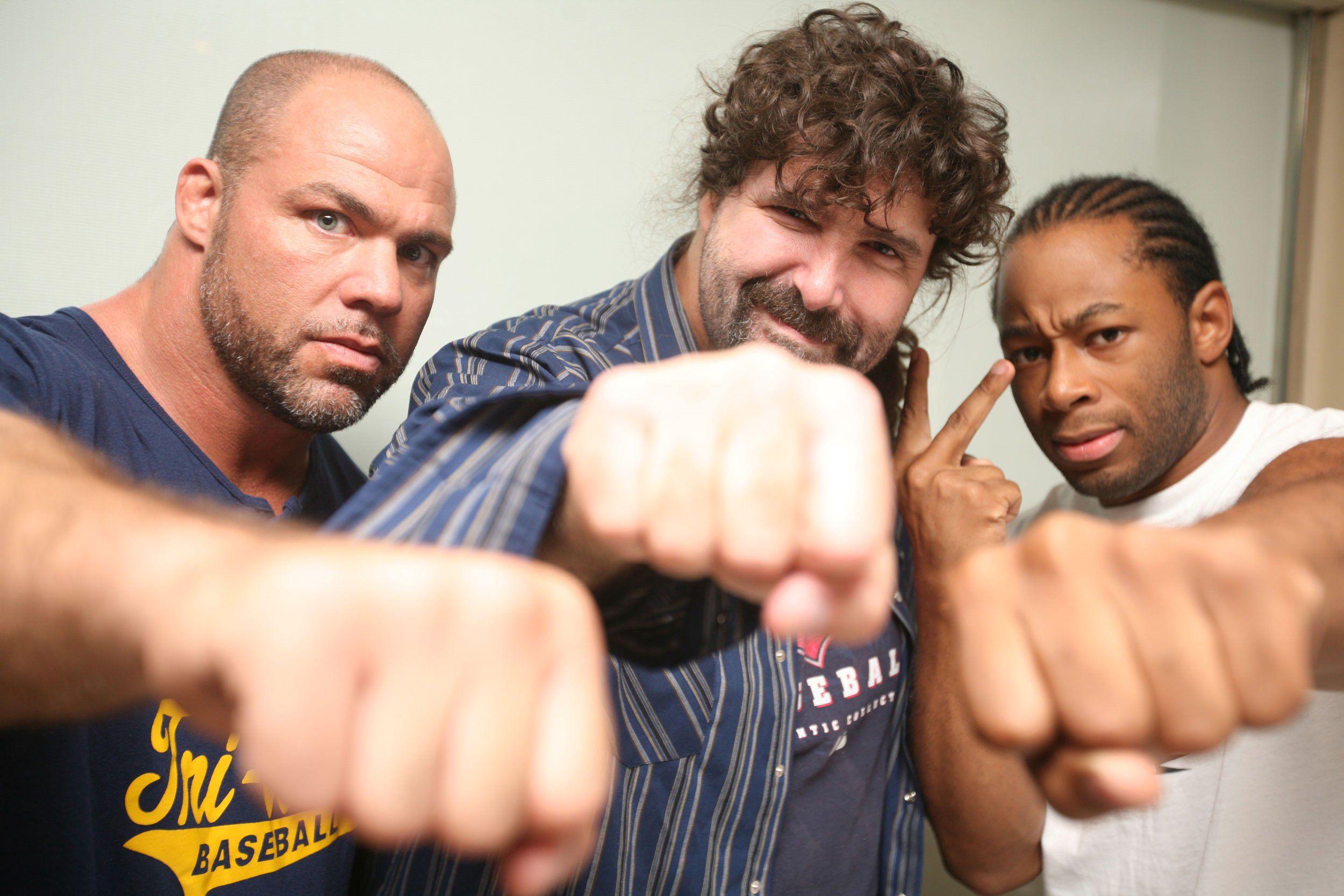
Despite the praise of his peers, Angle doesn’t have many friends, in or out of the business. When he was getting started in WWE, Vince McMahon’s right-hand man, Pat Patterson, told him that he wouldn’t keep in touch with his friends and colleagues after his career. Once you’re done with the business, Patterson told him, you’re done with them. "He was right," Angle says. "That’s just how it is. You’re brothers and you’re best friends, but once you go back to your families, you get on with your life. I can count the number of friends I have on my hand, and my wife is my best friend. She’s counted."
And here she is, arriving precisely at 8:30 p.m. "Daddy!" his daughters scream. "Did you guys have fun?" he asks, kneeling to hug them. "Are you ready to go?"
"I have three little kids who’ve never seen me wrestle," he says. "I want them to see me wrestle. They may not see me wrestle. My guess is that they will. I want them to see their dad wrestle one last time."
Angle is done for the night. Tomorrow a 9 a.m. Skype interview will interrupt his routine. Sometime in the next few days, he’ll find time to write his Hall of Fame speech. Like a good ring general, he plans to ad-lib some of it, but he has an idea of what he’ll say.
He wants to say thanks — thanks to his family, his fans, and Vince McMahon. He’ll also give advice to today’s WWE superstars. Take a chance, he’ll say, not in the ring, but with your character, because the fans remember the moments more than the matches. Even the five-star matches. "Don’t get so wrapped up in the wrestling," he’ll tell them.
"I want to talk about knowing when to get out," Angle says. "A lot of wrestlers don’t know when to get out. They get trapped and don’t want to lose that identity of who they are. It can mess up your quality of life.
"I’m gonna say some stuff about that."
Thomas Golianopoulos (@Golianopoulos) is a writer living in New York City. He has contributed to The New York Times, BuzzFeed, Grantland, and Complex.
